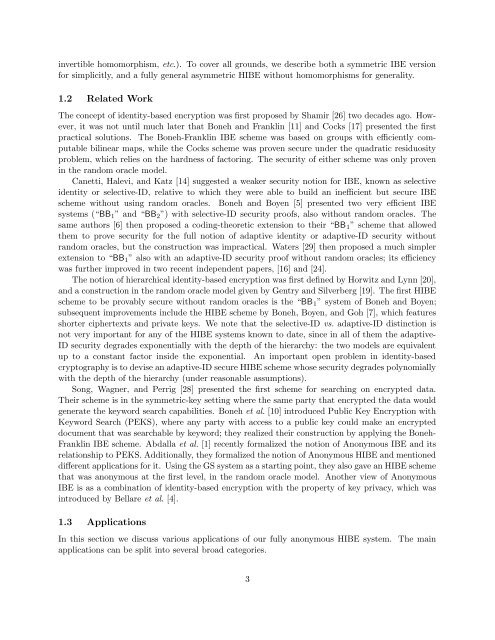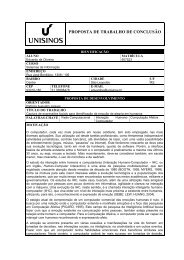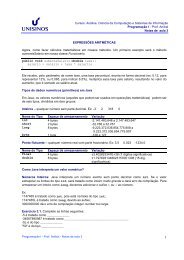“BB 1 ” and “BB 2 ”, and Waters’ by extension, may in fact become anonymous when implementedwith an “asymmetric” pairing e : G × Ĝ → G T under strong additional assumptions (such ashardness of DDH in G), but this is not easy to prove. Furthermore, for a fundamental reason thisobservation applies only to non-hierarchical IBE, and it would be nice not to rely on such “risky”assumptions which are patently false in the symmetric setting.At any rate, and even if one were to consider the use of random oracles, there simply doesnot exist any known hierarchical identity-based encryption scheme which is also anonymous. (Inparticular, the Gentry-Silverberg [19] HIBE scheme is not.) In their recent CRYPTO’05 paper,Abdalla et al. [1] cite the creation of an anonymous IBE system without random oracles and ananonymous HIBE system with or without random oracles as important open problems.1.1 Our ResultsWe present an <strong>Anonymous</strong> IBE and HIBE scheme without random oracles, therby solving bothopen problems from CRYPTO’05. Our scheme is very efficient for pure IBE, and reasonably efficientfor HIBE with shallow hierarchies of practical interest. We prove it secure based solely on Boneh’set al. [9] Decision Linear assumption, which is one of the mildest useful complexity assumptions inbilinear groups.At first sight, our construction bears a superficial resemblance to Boneh and Boyen’s “BB 1 ”HIBE scheme [5, §4] — but with at least two big differences. First, we perform “linear splittings”on various portions of the ciphertext, to thwart the trial-and-error identity guessing to which otherschemes fell prey. This idea gives us provable anonymity, even under symmetric pairings. Second,we use multiple parallel HIBE systems and constantly re-randomize the keys between them. Thisis what lets us use the linear splitting trick at all levels of the hierarchy, but also poses a technicalchallenge in the security reduction which mist now simulate multiple interacting HIBE systemsat once. Solving this problem was the crucial step that gave us a hierarchy without destroyinganonymity.Building a “flat” anonymous IBE system turns out to be reasonably straightforward using ourlinear splitting technique to hide the recipient identity behind some randomization. Complicationsarise when one tries to support hierarchical key generation. In a nutshell, to prevent collusionattacks in HIBE, “parents” must independently re-randomize the private keys they give to their“children”. In all known HIBE schemes, re-randomization is enabled by a number of supplementalcomponents in the public system parameters. Why this breaks anonymity is because the samemechanism that allows private keys to be publicly re-randomized, also allows ciphertexts to bepublicly tested for recipient identities. Random oracles offer no protection against this.To circumvent this obstable, we need to make the re-randomization elements non-public, and tiethem to each individual private key. In practical terms, this means that private keys must conveyextra components (although not too many). The real difficulty is that each set of re-randomizationcomponents constitutes a full-fledged HIBE in its own right, which must be simulated together withits peers in the security proof (their number grows linearly with the maximal depth). Because thesesystems are not independent but interact with each other, we are left with the task of simulatingmultiple HIBE subsystems that are globally constrained by a set of linear relations. A novelty ofour proof technique is a method to endow the simulator with enough degrees of freedom to reducea system of unknown keys to a single instance of the presumed hard problem.A notable feature of our construction is that it can be implemented using all known instantiationsof the bilinear pairing (whether symmetric or asymmetric, with our without a computable or2
invertible homomorphism, etc.). To cover all grounds, we describe both a symmetric IBE versionfor simplicitly, and a fully general asymmetric HIBE without homomorphisms for generality.1.2 Related WorkThe concept of identity-based encryption was first proposed by Shamir [26] two decades ago. However,it was not until much later that Boneh and Franklin [11] and Cocks [17] presented the firstpractical solutions. The Boneh-Franklin IBE scheme was based on groups with efficiently computablebilinear maps, while the Cocks scheme was proven secure under the quadratic residuosityproblem, which relies on the hardness of factoring. The security of either scheme was only provenin the random oracle model.Canetti, Halevi, and Katz [14] suggested a weaker security notion for IBE, known as selectiveidentity or selective-ID, relative to which they were able to build an inefficient but secure IBEscheme without using random oracles. Boneh and Boyen [5] presented two very efficient IBEsystems (“BB 1 ” and “BB 2 ”) with selective-ID security proofs, also without random oracles. Thesame authors [6] then proposed a coding-theoretic extension to their “BB 1 ” scheme that allowedthem to prove security for the full notion of adaptive identity or adaptive-ID security withoutrandom oracles, but the construction was impractical. Waters [29] then proposed a much simplerextension to “BB 1 ” also with an adaptive-ID security proof without random oracles; its efficiencywas further improved in two recent independent papers, [16] and [24].The notion of hierarchical identity-based encryption was first defined by Horwitz and Lynn [20],and a construction in the random oracle model given by Gentry and Silverberg [19]. The first HIBEscheme to be provably secure without random oracles is the “BB 1 ” system of Boneh and Boyen;subsequent improvements include the HIBE scheme by Boneh, Boyen, and Goh [7], which featuresshorter ciphertexts and private keys. We note that the selective-ID vs. adaptive-ID distinction isnot very important for any of the HIBE systems known to date, since in all of them the adaptive-ID security degrades exponentially with the depth of the hierarchy: the two models are equivalentup to a constant factor inside the exponential. An important open problem in identity-basedcryptography is to devise an adaptive-ID secure HIBE scheme whose security degrades polynomiallywith the depth of the hierarchy (under reasonable assumptions).Song, Wagner, and Perrig [28] presented the first scheme for searching on encrypted data.Their scheme is in the symmetric-key setting where the same party that encrypted the data wouldgenerate the keyword search capabilities. Boneh et al. [10] introduced Public Key <strong>Encryption</strong> withKeyword Search (PEKS), where any party with access to a public key could make an encrypteddocument that was searchable by keyword; they realized their construction by applying the Boneh-Franklin IBE scheme. Abdalla et al. [1] recently formalized the notion of <strong>Anonymous</strong> IBE and itsrelationship to PEKS. Additionally, they formalized the notion of <strong>Anonymous</strong> HIBE and mentioneddifferent applications for it. Using the GS system as a starting point, they also gave an HIBE schemethat was anonymous at the first level, in the random oracle model. Another view of <strong>Anonymous</strong>IBE is as a combination of identity-based encryption with the property of key privacy, which wasintroduced by Bellare et al. [4].1.3 ApplicationsIn this section we discuss various applications of our fully anonymous HIBE system. The mainapplications can be split into several broad categories.3
- Page 1: This paper is available from the IA
- Page 5 and 6: Informally, we say that an assumpti
- Page 7: 4 A Primer : Anonymous IBEWe start
- Page 10 and 11: Setup(1 Σ , D) To generate the pub
- Page 12 and 13: Encrypt(Pub, Id, Msg) To encrypt a
- Page 14 and 15: [9] Dan Boneh, Xavier Boyen, and Ho
- Page 16 and 17: Threshold. It is a known result [8]
- Page 18 and 19: Proof of Theorem 6. We prove the th
- Page 20 and 21: On the other hand, we have, for l =
- Page 22 and 23: CT ∗ real = [E, c 0, [c 0,(a) , c
- Page 24 and 25: and the re-randomization portion as
- Page 26 and 27: then, we can equate, for every l =
- Page 28: This concludes the description of t
















